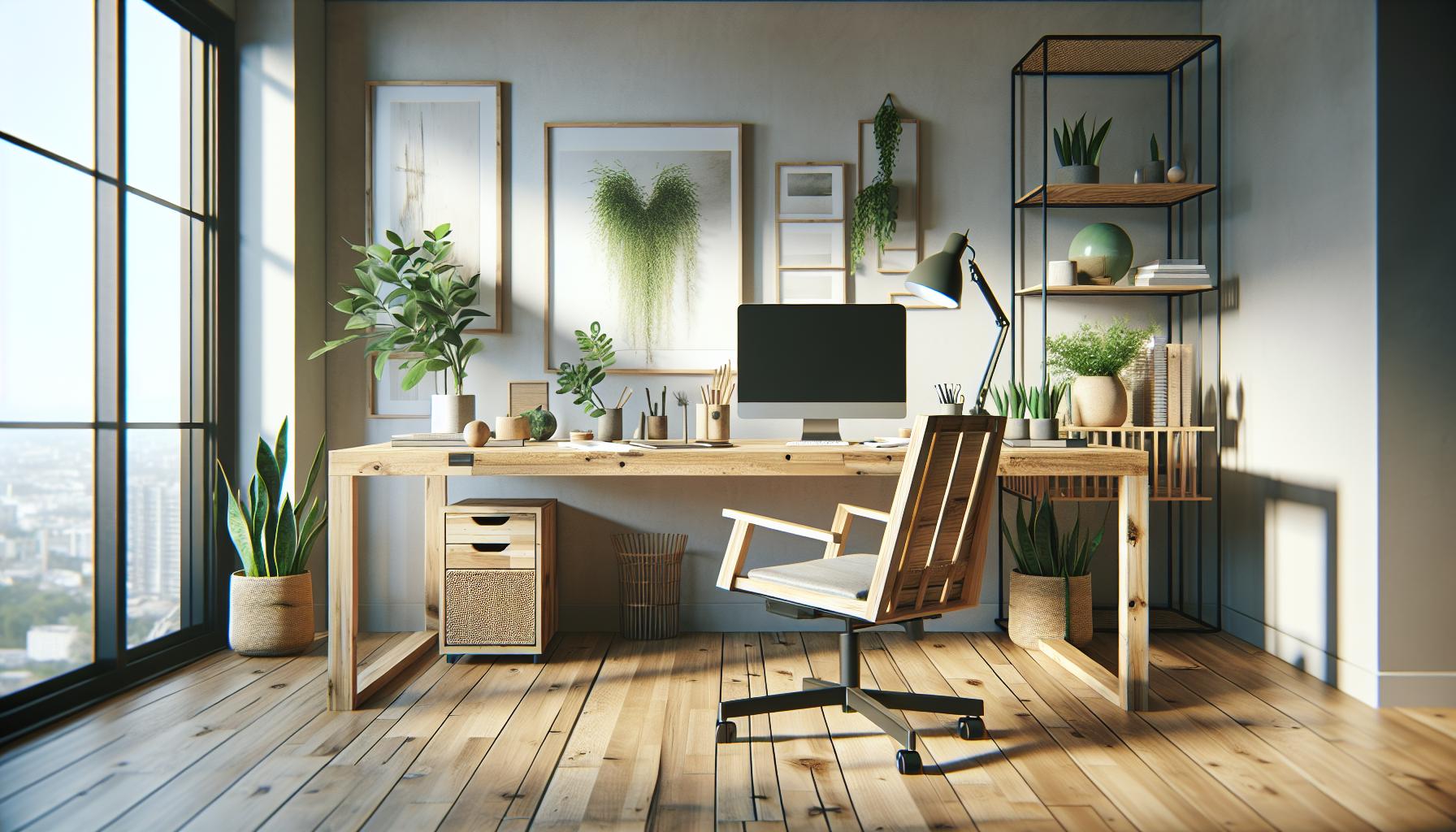As more of us embrace remote work, the importance of a sustainable home office has never been clearer. I’ve found that choosing eco-friendly furniture not only enhances my workspace but also contributes to a healthier planet. With options that prioritize sustainability, I can create an office that reflects my values while boosting productivity.
From reclaimed wood desks to recycled material chairs, sustainable home office furniture offers a blend of style and responsibility. It’s not just about aesthetics—these choices can lead to a more comfortable and inspiring environment. Join me as I explore the benefits of investing in sustainable pieces that make a difference, both for my work life and the world around us.
Key Takeaways
- Sustainable home office furniture enhances remote workspaces while positively impacting the environment.
- Eco-friendly options, such as reclaimed wood desks and recycled material chairs, promote a healthier work life and reduce ecological footprints.
- Investing in ergonomic designs not only supports comfort and good posture but also fosters productivity in the workspace.
- Choosing materials like bamboo and recycled items supports resource conservation and the circular economy while minimizing waste.
- Look for sustainability certifications (e.g., FSC, Greenguard) to ensure ethically sourced and environmentally safe products.
- Prioritize durability in furniture selections to reduce the need for frequent replacements, aligning sustainability goals with long-term investment.
Sustainable Home Office Furniture
Sustainable home office furniture comprises items made from eco-friendly, renewable, or recycled materials. These furniture pieces minimize the environmental impact while promoting a healthier workspace. I can choose furniture designed for durability and longevity, reducing the need for frequent replacements.
Reclaimed wood desks serve as excellent examples of sustainable furniture. They incorporate salvaged timber, preserving forests while providing unique character and style. Additionally, chairs made from recycled materials, such as plastic or metal, contribute significantly to waste reduction efforts.
Brands prioritizing sustainability often utilize environmentally friendly manufacturing processes. By implementing techniques that decrease waste and energy consumption, these companies ensure responsible production. Selecting furniture from such brands supports a circular economy, where materials are reused and repurposed effectively.
Moreover, investing in ergonomic designs not only enhances comfort but also promotes good posture. Sustainable furniture often includes features that support health, creating a functional and stylish work environment. This commitment to health and sustainability reinforces my values while creating a positive impact on the planet.
Benefits of Sustainable Furniture

Sustainable furniture offers significant advantages, particularly regarding environmental protection and personal well-being. Here’s a deeper look into these benefits:
Environmental Impact
Sustainable furniture significantly reduces environmental harm. I’d choose items crafted from renewable resources, such as bamboo, or utilize reclaimed materials, which help decrease deforestation. Producing eco-friendly furniture often entails lower carbon emissions due to fewer chemicals and energy-efficient processes. By selecting sustainable options, I contribute to the circular economy, ensuring that resources stay in use longer. This choice minimizes waste and fosters a healthier planet for future generations. Additionally, I can create QR codes with Adobe Express to streamline access to digital documents or resources, adding a tech-savvy touch to my sustainable workspace.
Health Benefits
Sustainable furniture also enhances overall health. Ergonomically designed pieces often promote proper posture, reducing the risk of musculoskeletal issues. Many sustainable materials, such as non-toxic finishes, improve indoor air quality, decreasing exposure to harmful chemicals. Investing in sustainable furniture supports not only physical well-being but also mental health, as a well-organized, eco-friendly workspace fosters productivity and reduces stress. Choosing sustainable options creates a home office that prioritizes both comfort and health.
Types of Sustainable Home Office Furniture

Selecting sustainable home office furniture involves making eco-conscious choices across multiple categories. Here are key components to consider when outfitting your workspace.
Desks
Desks crafted from reclaimed wood offer distinctive character and promote resource conservation. These pieces not only reduce the demand for new timber but also showcase the beauty of natural materials. Bamboo desks stand out for their rapid growth and renewability, providing a strong, stylish option. Additionally, desks made from recycled metal deliver durability and sustainability. Incorporating adjustable standing desks enhances both comfort and health, supporting ergonomic needs while minimizing environmental impact.
Chairs
Chairs produced from recycled materials effectively address waste while providing comfort and support. Ergonomic designs prioritize posture, ensuring long hours at the desk remain enjoyable and pain-free. Many brands utilize sustainable upholstery, such as organic cotton or recycled polyester, which contribute to reduced chemical usage and improved indoor air quality. Consider other options like bamboo or cork chairs, which offer both style and sustainability through their renewable sources.
Storage Solutions
Storage solutions from reclaimed or sustainable materials help maintain an organized workspace. Shelving made from recycled wood or metal not only supports environmental efforts but also adds a unique aesthetic to the home office. Modular storage units allow flexibility while promoting responsible material usage. Employing eco-friendly storage bins made from sustainable fibers enhances organization without harming the environment. These choices encourage an efficient, clutter-free environment that aligns with sustainable practices.
Materials Used in Sustainable Furniture

Sustainable home office furniture utilizes various eco-friendly materials that contribute to environmental preservation. Here are some key materials that support sustainability.
Bamboo
Bamboo offers a robust and sustainable alternative to traditional hardwoods. This fast-growing grass reaches maturity in about three to five years, making it an incredibly renewable resource. Bamboo’s natural strength results in durable products, ideal for desks and shelving. Its lightweight character allows for versatile designs, enhancing both aesthetics and function in a home office. Additionally, bamboo absorbs more greenhouse gases than most trees, further contributing to environmental health.
Recycled Materials
Recycled materials significantly reduce waste and resource consumption in furniture production. Manufacturers often repurpose items like plastic bottles, scrap metals, and old wood into stylish office furniture. For example, chairs made from recycled plastics can maintain comfort while minimizing landfill contributions. Incorporating recycled materials into designs not only supports circular economy principles but also promotes creative solutions in furniture manufacturing, offering a unique character and story to each piece.
Organic Fabrics
Organic fabrics ensure that upholstered furniture remains non-toxic and environmentally friendly. These materials, made from natural fibers like cotton, linen, or wool, avoid harmful chemicals and pesticides in their production. Organic upholstery not only enhances indoor air quality but also provides comfort and durability, essential for daily use. By choosing furniture with organic fabrics, I support sustainable agricultural practices and reduce my overall environmental footprint.
Tips for Choosing Sustainable Home Office Furniture
Selecting sustainable home office furniture requires attention to detail. I focus on materials, certifications, and durability to make informed choices that benefit both my workspace and the environment.
Assessing Sustainability Certifications
I always check for sustainability certifications when selecting furniture. Certifications like the Forest Stewardship Council (FSC) indicate responsible sourcing of wood. Look for Greenguard or Cradle to Cradle certifications, which confirm that products meet strict chemical emissions standards, promoting better indoor air quality. Other labels, such as the Global Organic Textile Standard (GOTS), ensure the use of organic and non-toxic materials in textiles. Prioritizing certified products helps me ensure ethical and safe choices for my home office.
Considerations for Durability
I emphasize durability while choosing furniture since sustainable options should last. Selecting high-quality materials, like solid wood or metal, ensures longevity and minimizes waste. I also consider the design; furniture with timeless styles often stays relevant longer, reducing the need for future replacements. Investing in items that combine durability with sustainable materials, like bamboo or reclaimed wood, creates a resilient workspace. A durable choice supports long-term environmental goals while maintaining a stylish and functional office.
Eco-friendly Materials and Designs
Choosing sustainable home office furniture is more than just a trend; it’s a commitment to a healthier planet and a more productive workspace. By selecting eco-friendly materials and designs, I can create an office that not only looks great but also supports my values.
Investing in items like reclaimed wood desks or chairs made from recycled materials enhances my work environment while reducing my carbon footprint. Plus, the ergonomic benefits of sustainable furniture help me maintain comfort and focus throughout the day.
As I continue to work remotely, embracing sustainability in my home office is a step towards making a positive impact. It’s about creating a space that reflects my dedication to both personal well-being and environmental responsibility.

